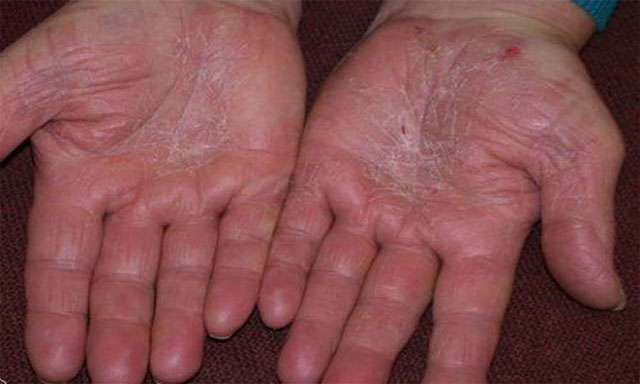Asian disease is what disease?
Asian horn is a skin disease, cracked skin bleeding called chicken neck break, often worsens when the weather is dry, so long it is difficult to treat.
Dr. Luong Truong Son, Deputy Director of Ho Chi Minh City Insect Parasite Malaria Specialist, a dermatologist, said that Asian horn or dry eczema is a condition in which the horns are differentiated and the cells are still in progress born, not transformed into horns. Asian horn causes incomplete desquamation of the skin, usually occurring in hands and feet. The disease causes pain, bloody skin cracking, walking, hard labor, loss of aesthetics, lack of confidence in communication .
The disease is more common among young people such as restaurant staff, cooks, housewives, medical workers, hairdressers, needlework, fruit and vegetable sellers, seafood . The rate of female diseases is higher than that of men.

Asian horn causes incomplete desquamation of the skin, usually occurring in hands and feet.
The cause of hyperkeratosis so far has not been determined , but it may be due to genetic factors in the family or unbalanced nutritional habits from babies. In fact, the vast majority of patients eat less fruits and vegetables, especially vitamins A, C, D, E .
Some of the risk factors for atopic dermatitis, which are favorable for the process of developing keratosis, are foods such as onion, garlic, radish, grape juice, orange, shrimp, and fish. Household appliances such as rubber gloves, nickel plating of some utensils and jewelry, PPD (paraphenylenediamine) found in nail polish or detergent solutions, dishwashing liquid .
The dry winter climate also makes the cracking condition worse, the skin is prone to splitting, bloody, deep cracked at the base of the finger called broken chicken neck, painful walking. If not hygienic, the patient is susceptible to secondary infections causing swelling, lymphadenopathy, fever.
The incidence of hyperkeratosis (dry eczema) is increasing, not only concentrated in rural areas but even in urban areas, due to the lack of moderation in lifestyle and environmental pollution.
Symptoms of hyperkeratosis appear on the palms, feet and fingers, toes appear red skin, dry skin and cracked skin, incomplete desquamation, if peeling scales will cause skin tearing, bleeding. A common place is the hands and fingers, especially in the front 1/3 of the hands and feet.
Severe illness in the winter, decreased in the summer , sometimes completely ceased, until the winter of the following year. Chronic inflammatory disease, when the body has a hormonal change that can go away on its own such as puberty, pregnancy, menopause .
The principle of treatment of hyperkeratosis is to heal lesions quickly, improve immunity, fight against recurrence, clean the environment and change the working environment accordingly.
When suffering from Asian horn, you can use topical drugs such as salixilic acid, diprosalic, betnovate . Dry cream, broad-spectrum antibiotics, antifungal drugs: Nizoral, imidazol derivatives, griseofulvin. In severe cases, corticosteroids and antihistamines may be required.
Avoid peeling skin, blisters, scrub too vigorously scrubbing with scrub stones, brushes . leading to scratching the horny layer, creating conditions for infection. Do not soak to wash hands and feet. Take care to keep the lines dry. The stratum corneum is inherently moist, so it is more susceptible to fungus attack. Supplement vitamins by eating fruits of every day, improving the body's resistance.
- Impressive images of Asian students of the last century
- Domestic dog virus threatens Asian tigers
- The Alliance for the Protection of Asian Dogs was established
- Asian wasps became the fear of Europe
- Diabetes can reach 'pandemic' level in Asia
- The gene that causes IgAN kidney disease in humans has been discovered
- More than 800 million Asian men are descended from 11 ancestors
- US President and David Beckham offered to lose to the Asian squatting ability
- Asian carp 'invaded' waters in Canada and the United States
- Asia is concerned about the outbreak of foot and mouth disease
- Portrait of giant bee killing mass in Asia
- Some Asian frog species may become extinct before being discovered
 Chinese doctors have created medical masks that cover only the nose for convenience of eating and drinking
Chinese doctors have created medical masks that cover only the nose for convenience of eating and drinking Scientists have found a way to help you regrow new teeth after only 2 months
Scientists have found a way to help you regrow new teeth after only 2 months Do non-stick pans cause cancer? What alternatives are there?
Do non-stick pans cause cancer? What alternatives are there? Blisters around the body: Causes, symptoms and treatment
Blisters around the body: Causes, symptoms and treatment